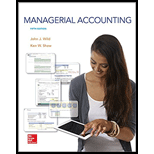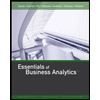
Concept explainers
Concept introduction:
Break-Even Point: The level of sales at which profits are zero refers to break-even point. In other words, it is the point where total revenue equals total cost and total contribution margin equals total fixed cost.
Requirement 1a:
To compute:
The break-even point in sales units for Praveen Co. that manufactures and markets a number of rope products.
Concept introduction:
Break-Even Point: The level of sales at which profits are zero refers to break-even point. In other words, it is the point where total revenue equals total cost and total contribution margin equals total fixed cost.
Requirement 1b:
To compute:
The break-even point in sales dollars for Praveen Co. that manufactures and markets a number of rope products.
Concept introduction:
Break-Even Point: The level of sales at which profits are zero refers to break-even point. In other words, it is the point where total revenue equals total cost and total contribution margin equals total fixed cost.
Cost-volume-profit chart: Cost-volume-profit chart is very useful in the planning phase of a business. It involves predicting the volume of sales activity, the costs to be incurred, revenues to be received, and profits to be earned. It is also useful in what-if analysis.
Requirement 2:
To prepare:
The CVP chart for Product XT using 7000 units as the maximum number of sales units on the horizontal axis of the graph and $1, 400, 000 as the maximum dollar amount on the vertical axis.
Concept introduction:
Break-Even Point: The level of sales at which profits are zero refers to break-even point. In other words, it is the point where total revenue equals total cost and total contribution margin equals total fixed cost.
Requirement 3:
To prepare:
The contribution margin income statement showing sales, variable costs and fixed costs for Product XT as the break-even point.
Want to see the full answer?
Check out a sample textbook solution
Chapter 5 Solutions
MANAGERIAL ACCOUNTING FUND. W/CONNECT
- I am looking for the correct answer to this general accounting problem using valid accounting standards.arrow_forwardPlease help me solve this general accounting problem with the correct financial process.arrow_forwardPlease provide the answer to this general accounting question using the right approach.arrow_forward
- I need help with this general accounting question using standard accounting techniques.arrow_forwardmanagerial accounting questionarrow_forwardA firm is considering making a change to its capital structure to reduce its cost of capital and increase firm value. Right now, it has a capital structure that consists of 20% debt and 80% equity, based on market value. The risk-free rate is 6% and the market risk premium is 5%. Currently the company's costs of equity, which is based on the CAP<, is 12.5% and its tax rate is 40%. What would be Carwright's estimated cost of equity if it were to change its capital structure to 60% debt and 40% equity?arrow_forward
- A company has the following data, in thousands. Assuming a 365-day year, what is the firm's cash conversion cycle? Annual Sales = $45,000 Annual cost of goods sold = $31,500 Inventories = $4,250 Accounts receivable = $2,000 Accounts payable = $3,400arrow_forwardaccounting questionarrow_forwardsubject = general accountingarrow_forward
 Essentials of Business Analytics (MindTap Course ...StatisticsISBN:9781305627734Author:Jeffrey D. Camm, James J. Cochran, Michael J. Fry, Jeffrey W. Ohlmann, David R. AndersonPublisher:Cengage LearningPrinciples of Accounting Volume 2AccountingISBN:9781947172609Author:OpenStaxPublisher:OpenStax College
Essentials of Business Analytics (MindTap Course ...StatisticsISBN:9781305627734Author:Jeffrey D. Camm, James J. Cochran, Michael J. Fry, Jeffrey W. Ohlmann, David R. AndersonPublisher:Cengage LearningPrinciples of Accounting Volume 2AccountingISBN:9781947172609Author:OpenStaxPublisher:OpenStax College Cornerstones of Cost Management (Cornerstones Ser...AccountingISBN:9781305970663Author:Don R. Hansen, Maryanne M. MowenPublisher:Cengage Learning
Cornerstones of Cost Management (Cornerstones Ser...AccountingISBN:9781305970663Author:Don R. Hansen, Maryanne M. MowenPublisher:Cengage Learning Managerial Accounting: The Cornerstone of Busines...AccountingISBN:9781337115773Author:Maryanne M. Mowen, Don R. Hansen, Dan L. HeitgerPublisher:Cengage Learning
Managerial Accounting: The Cornerstone of Busines...AccountingISBN:9781337115773Author:Maryanne M. Mowen, Don R. Hansen, Dan L. HeitgerPublisher:Cengage Learning



